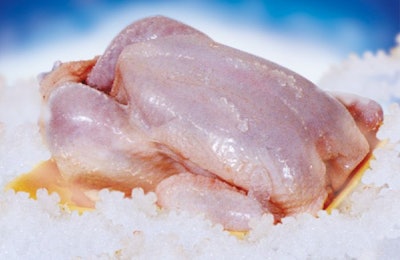
Good poultry processing operations will keep rejects, partial or complete, to a minimum. There are several procedures at the processing plant where a few simple checks can help to ensure carcasses are produced to the highest possible quality and that downgrades are as few as possible.
1. Correct handling
When removing birds from cages for hanging on the overhead conveyor, they need to be handled properly to reduce the number of rejects.
To minimize bruising, birds’ legs should be gripped using the middle and index fingers and the thumb, making a circle around the leg and ensuring a 90-degree angle between the leg and the hangers’ fingers.
Too often, when workers remove birds from the cages, too much pressure is applied to the joints, resulting in bruising, which then leads to downgrades.
2. Ensuring safe transit to stunning
Passage to the stunning bath should last no longer than 30 seconds to prevent excess blood filling the blood vessels due to the forces of gravity.
Birds need to remain calm during this journey and, by having their vision restricted, they will tend to flap less. This can be achieved by shielding them, using plastic or stainless steel sheets with only necessary observation windows. Not only will less flapping help to prevent wings being damaged, it will also reduce additional blood flow.
Monitoring this part of operations will control the number of birds downgraded or rejected due to bruising and blood accumulation.
3. Prevent pre-shock
Should birds become agitated prior to entering the stunning bath, they will flap their wings and, if the entry to the stunning bath is damp, any contact between the bird and the damp surface will result in a pre-shock.
Should this occur, birds will become very excited, flap intensely and lift their heads. If their heads do not enter the water bath, they will leave the stunning area completely conscious. In automatic killing systems, this will result in more work for the team that ensures that all birds are killed, as unstunned birds will have to be killed by hand.
4. Slaughter and bleed out
Ensure that no more than 10-12 seconds elapse between exiting the water bath and entry to the manual or automatic killer. If this period is shorter or longer, bleed-out quality will be affected and birds may exit the plucker with a reddish appearance, or even enter the plucker still alive.

As the quality of processed birds deteriorates, the greater the likelihood of condemnation. | Eduardo Cervantes López
5. Scalding uniformity
Birds must be fully emerged in the scalders and water agitation must be uniform across the various tanks to ensure successful plucking.
A failure to ensure this will have consequences when it comes to feather removal.

Chickens must be completely submerged during scalding. | Eduardo Cervantes López
6. Plucking
To ensure successful plucking, birds must arrive at the pluckers with a relatively high surface temperature, particularly on the breast and back, of approximately 45 C.
Depending on atmospheric conditions where the plant is located, the water used in the plucker should be 34-40 C to prevent skin from overheating.
Water jets must be directed toward the plucking fingers to stop feathers accumulating and water pressure should not be above 30 psi, as studies have shown that higher pressure can result in fecal matter and bacteria being forced into the carcass.
Plucking fingers must be checked at the end of each day to ensure they are not broken and that ridges have not been worn away.
Plucking equipment must be correctly angled to achieve the greatest possible effectiveness in wing and tail feather removal.
It is at exit from the plucker that issues with feed withdrawal can be observed. If feed withdrawal has been too short, during the journey to the stunner, pressure will be placed by any remaining feed on the bird’s trachea, making breathing difficult. This sensation of suffocation will cause the birds to flap their wings, risking damage. Should evidence of poor feed withdrawal be evidenced when the birds exit the last plucker, this must be reported back to the farm so that it can be avoided in the future.
Poultry processing requires mix of expertise, automation















